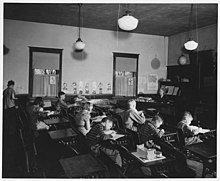
One-room schools, or schoolhouses, were commonplace throughout rural portions of various countries, including Prussia, Norway, Sweden, the United States, Canada, Australia, New Zealand, the United Kingdom, Ireland, Portugal, and Spain. In most rural and small town schools, all of the students met in a single room. There, a single teacher taught academic basics to several grade levels of elementary-age children. While in many areas one-room schools are no longer used, some remain in developing nations and rural or remote areas where scarce students or teachers complicate organizing the educational process differently.
In the United States, the concept of a "little red schoolhouse" is a stirring one, and historic one-room schoolhouses have widely been preserved and are celebrated as symbols of frontier values and of local and national development. When necessary, the schools were enlarged or replaced with two-room schools. More than 200 are listed on the U.S. National Register of Historic Places. In Norway, by contrast, one-room schools were viewed more as impositions upon conservative farming areas, and, while a number survive in open-air museums, not a single one is listed on the Norwegian equivalent to the NRHP.
Prussia
Further information: Prussian education system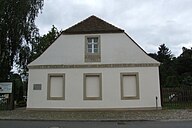
 One-room school in Reckahn, Brandenburg an der Havel, founded 1773, now a museum
One-room school in Reckahn, Brandenburg an der Havel, founded 1773, now a museum
Prussia was among the first countries in the world to introduce a tax-funded and generally compulsory primary education for either boys and girls. In comparison, compulsory schooling in France or Great Britain was not successfully enacted until the 1880s. The state-sponsored system was introduced in the late 18th century and has had a widespread influence ever since. The first Prussian schools were simple one-room schools, but by 1773 Friedrich Eberhard von Rochow had already set up a model school with primary education in two separate age-grouped classes.
Ireland
In Ireland, free primary education was mandated in 1831, prompting the establishment of many single-teacher National Schools across rural areas, most initially using a room in an existing building. By the 1890s there was a school in every parish. Most extant one- and two-room school buildings date from the decades after 1891 when primary education became compulsory. Most of those still in use today have been extended following merger with neighbouring schools. Since 2002, any state-funded school with at least 10 pupils is entitled to at least 2 teachers; the 21 schools which fell below this threshold are located on offshore islands. In recent decades, an increasing number of schools have been founded for parents not content with the National School system. These include Gaelscoileanna (which teach through Irish rather than English) and multi-denominational schools (most Irish schools are controlled by one or other of the main Christian churches). Although such schools eventually become eligible for state funding, they usually begin with a single teacher in a room or prefabricated building.
United States
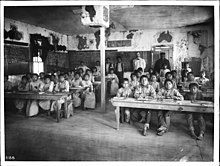
One-room schools were used only in rural areas. As late as 1930 half of the nation's school children lived in rural areas. About 65% of the nation's school buildings were one-room, and they were attended by 30% of the rural students. Consolidation rapidly reduced their numbers in the 1920s and 1930s. They had a place in popular folklore, with one fondly recalling a, "little house, on a little ground, with a little equipment, where a little teacher at a little salary, for a little while, teaches little children little things." A less romantic view by sociologist Newell Sims reported on the majority of rural schools of all sizes in the 1930s:
The utter inadequacy of the majority is the striking feature of rural school buildings. They are poorly situated, often without any grounds, or, with grounds that are grassless, treeless and beautyless. As structures they are poorly planned, poorly lighted, poorly heated, poorly seated, poorly equipped or virtually unequipped either for comfort or education, and poorly kept. Drinking water is not usually supplied. Sanitary arrangements and toilet facilities are as likely to be entirely lacking as to be provided in even a half-way decent manner.
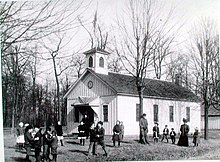
Teachers in one-room schools were usually daughters of nearby farmers. They were recent graduates and spent a couple of years teaching before they quit to get married. The teachers were poorly prepared and needed to coach children of all ages/grades within one room. Their main role is well-described by a student from Kentucky in the 1940s:
The teachers that taught in the one room, rural schools were very special people. During the winter months they would get to the school early to get a fire started in the potbelly stove, so the building would be warm for the students. On many occasions they would prepare a hot, noon meal on top of the stove, usually consisting of soup or stew of some kind. They took care of their students like a new mother hen would care for her newly hatched chicks; always looking out for their health and welfare.
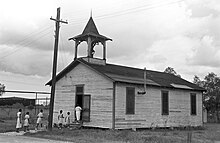
A typical school day was 9 a.m. to 4 p.m., with morning and afternoon recesses of 15 minutes each and an hour period for lunch. "The older students were given the responsibility of bringing in water, carrying in coal or wood for the stove. The younger students would be given responsibilities according to their size and gender such as cleaning the black board (chalkboard), taking the erasers outside for dusting plus other duties that they were capable of doing."
Transportation for children who lived too far to walk was often provided by horse-drawn kid hack or sulky, which could only travel a limited distance in a reasonable amount of time each morning and evening, or students might ride a horse, these being put out to pasture in an adjoining paddock during the day. In more recent times, students rode bicycles.
Southern students and teachers most often walked to and from school; a three-mile journey was not uncommon. Due to the poor quality of roads, automobiles were not frequently used.
The vast majority of one-room schools have been torn down; a few were converted for other purposes. However, in a handful of rural communities, such as Mennonites and Amish, one-room or two-room schools survived longer. As of 2005, almost 400 one-rooms schools still operate in the United States.
Teacher's residence

The teacher's residence, or teacherage, was often attached to the school, or very close by, so that a male teacher's wife and family were an integral part of the management and support system for the school. Single, female teachers were more often billeted or boarded with a local family to provide for social norms requiring social supervision of single females.
Consolidation
Motorized school buses in the 1920s made longer distances possible, and one-room schools were soon consolidated in most portions of the United States into multiple classroom schools where classes could be held separately for various grade levels. Gradually, one-room school houses were replaced. Most one-room schools had been replaced by larger schools by World War II except in the most rural areas. However, they are still found in remote parts of Alaska where villages have a small population.
Preservation: buildings and cultural

In Calvert County, Maryland, Port Republic School Number 7 closed its doors in 1932 and sat unused for over 40 years. Then, in 1976 the Calvert Retired Teachers Association, looking for a Bicentennial Year project, decided to restore the one-room schoolhouse. On July 24, 1977, after months of hard work by teachers and community volunteers, the old school bell rang out once more, and the little one-room school house, filled with its memories and memorabilia, was ready for visitors. It is now one of the county's tourist attractions. A similar project was done in Queen Anne's County, Maryland, by retired Teachers and Community Volunteers. The restored schoolhouse is located in front of Queen Anne's County High School. In Iowa, over 125 small one-room school houses have been turned into local museums. The buildings in some places found new purpose as homes.
In Harrisburg, Nebraska, Flowerfield School serves as a living museum, and fourth-graders within the Nebraska panhandle spend a day at Flowerfield going through an average school day in 1888. The students have the opportunity to experience both log and sod versions of the house, writing with quill pens, and a trip to the nearby museum, where they learn about other aspects of life in 1888.
In Vandalia, Indiana, the Vandalia District No. 2 one-room schoolhouse served Owen County's Lafayette Township students in grades 1 – 8 from the time it was completed in 1868 until it closed in 1951. The building, restored by a group of volunteers in 1976, is presently maintained and preserved by the Vandalia Community Preservation Association.
The One Room School House Project of Southwestern College in Winfield, Kansas, includes listings and information on some 880 schools throughout the state and nation. The information, pictures, and stories included in this site have been collected and sent to the project by researchers and historians from across America.
Gallery
-
 The one-room blab school attended by Abraham Lincoln in 1822
The one-room blab school attended by Abraham Lincoln in 1822
-
 The Knick School in Darke County, Ohio in 1996
The Knick School in Darke County, Ohio in 1996
-
 St. John the Baptist Church (1841) and a one-room schoolhouse (1845) with an attached teacherage, now a working museum in Canberra, Australia
St. John the Baptist Church (1841) and a one-room schoolhouse (1845) with an attached teacherage, now a working museum in Canberra, Australia
-
Port Republic School #7 in Calvert County, Maryland
-
The Eureka Schoolhouse in Springfield, Vermont, was built in 1785 and in continuous use until 1900
-
 The Felta Schoolhouse in Sonoma County, California was built in 1906 and closed on November 27, 1951
The Felta Schoolhouse in Sonoma County, California was built in 1906 and closed on November 27, 1951
-
The one-room adobe schoolhouse in Lochiel, Arizona
-
 The Copper Harbor Room School
The Copper Harbor Room School
-
 One-room school in Granite, Colorado in 1954
One-room school in Granite, Colorado in 1954
-
 The Harvey One-Room School in Bucyrus Township, Ohio, built in 1876
The Harvey One-Room School in Bucyrus Township, Ohio, built in 1876
-
 Vandalia, Indiana, Owen County, Lafayette Township District #2 Schoolhouse was completed around 1868 and closed in 1951. It is preserved and maintained by the Vandalia Community Preservation Association
Vandalia, Indiana, Owen County, Lafayette Township District #2 Schoolhouse was completed around 1868 and closed in 1951. It is preserved and maintained by the Vandalia Community Preservation Association
-
 North Bass Island School, a one-room school with teacherage on Isle St. George of the Lake Erie Bass Islands was the last operating one-room school in Ohio. It ceased operations in 2005, and is maintained as an island heritage centre. K-8 students attended the school and flew to another island or the mainland for high school.
North Bass Island School, a one-room school with teacherage on Isle St. George of the Lake Erie Bass Islands was the last operating one-room school in Ohio. It ceased operations in 2005, and is maintained as an island heritage centre. K-8 students attended the school and flew to another island or the mainland for high school.
-
 The Prudence Island Schoolhouse on Prudence Island in Portsmouth, Rhode Island is the last operating one-room school in Rhode Island
The Prudence Island Schoolhouse on Prudence Island in Portsmouth, Rhode Island is the last operating one-room school in Rhode Island
-
 The Brick School House in Coventry, Connecticut, was built in 1825 and closed in 1953. It is now a local museum and the only one-room school open to the public in Connecticut
The Brick School House in Coventry, Connecticut, was built in 1825 and closed in 1953. It is now a local museum and the only one-room school open to the public in Connecticut
-
 Pleasant Point District 24 One-Room School, Rush County, Kansas. The school opened in 1907 and closed in 1959. Maintained by the Rush County Historical Society.
Pleasant Point District 24 One-Room School, Rush County, Kansas. The school opened in 1907 and closed in 1959. Maintained by the Rush County Historical Society.
-
 Waldron School, Wheeler County, Oregon, built in 1879
Waldron School, Wheeler County, Oregon, built in 1879
See also
- Little Red Schoolhouse
- A-b-c-darian, the youngest students in a one-room school
- Blab school
- Micro-schooling
- Ranch school
- Ungraded school
References
- ^ Leidulf Mydland (Spring 2001). "The legacy of one-room schoolhouses: A comparative study of the American Midwest and Norway". European Journal of American Studies. 6. doi:10.4000/ejas.9205.
- See Category:One-room schoolhouses in the United States.
- James van Horn Melton, Absolutism and the Eighteenth-Century Origins of Compulsory Schooling in Prussia and Austria (2003)
- Nuhoglu Soysal, Yasemin; Strang, David (1989). "Construction of the First Mass Education Systems in Nineteenth-Century Europe". Sociology of Education. 62 (4): 277–288. doi:10.2307/2112831. JSTOR 2112831.
- ONLINE, RP (2011-12-14). "Städte dürfen Zwergschulen behalten". RP ONLINE (in German). Retrieved 2023-02-02.
- "Key Statistics about the Department's Customers". Department of Education and Skills. Retrieved October 26, 2011.
- Wayne E. Fuller, One-Room Schools of the Middle West: An Illustrated History (1994)
- Sims, p. 539.
- See also Jonathan Zimmerman, Small Wonder: The Little Red Schoolhouse in History and Memory (2009).
- Sims, p. 540.
- "One Room School". snowkentucky.com. Archived from the original on October 3, 2011. Retrieved October 26, 2011.
- Gifford, James M. (2011). Mohr, Clarence L. (ed.). The New Encyclopedia of Southern Culture: Volume 17: Education. UNC Press. pp. 272–274.
- Mark W. Dewalt, and Bonnie K. Troxell. "Old order Mennonite one-room school: A case study." Anthropology & education quarterly (1989): 308-325.
- "America's One-Room Schools". NPR.org. Retrieved 2019-01-22.
- "One-Room Schoolhouse". Calvert County Living. Retrieved October 26, 2011.
- "Flowerfield School". Flowerfield School. 2005. Archived from the original on April 2, 2012. Retrieved October 26, 2011.
- "Vandalia Community Preservation Association". Organization Founded 1995.
- "The Blade | Toledo's breaking news, sports, and entertainment watchdog".
Further reading
- Cochrane, Jean. The One-Room School in Canada (1981). summary
- Fuller, Wayne E. One-Room Schools of the Middle West: An Illustrated History (1994) summary
- Leight, Robert L., and Alice D. Rinehart. "Revisiting Americana: One-room school in retrospect." The Educational Forum 56#2 (1992) pp. 133-151 online
- Montell, William Lynwood. Tales from Kentucky one-room school teachers (University Press of Kentucky, 2011) online.
- Parsley, Danette, and Rhonda Barton. "The myth of the little red schoolhouse: Challenges and opportunities for rural school improvement." Peabody Journal of Education 90.2 (2015): 191-193. link
- Sims, Newell Leroy. Elements Of Rural Sociology (3rd ed. 1940) online
- Sloane, Eric. The little red schoolhouse (Courier, 2012) online.
- Theobald, Paul. "Country school curriculum and governance: The one-room school experience in the nineteenth-century Midwest." American journal of education 101.2 (1993): 116-139.
- Zimmerman, Jonathan (2009). Small Wonder: The Little Red Schoolhouse in History and Memory. Yale University Press.
External links
- Audio Interview with 1920 student in 1820 1-room schoolhouse in E. Fishkill, NY (55 min.)
- One Room School Houses in the Ottawa Valley
- CSAA a National One-Room Schoolhouse Support Organization
- One Room School House Project of Southwestern College
- University of Northern Iowa - One-room School Museum
| School types | |||||||||||||||
|---|---|---|---|---|---|---|---|---|---|---|---|---|---|---|---|
| By educational stage |
| ||||||||||||||
| By funding / eligibility |
| ||||||||||||||
| By style / purpose |
| ||||||||||||||
| By location | |||||||||||||||
| By scope | |||||||||||||||
| Historical |
| ||||||||||||||
| Related topics | |||||||||||||||